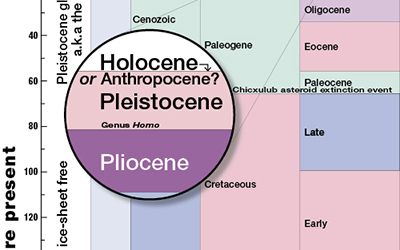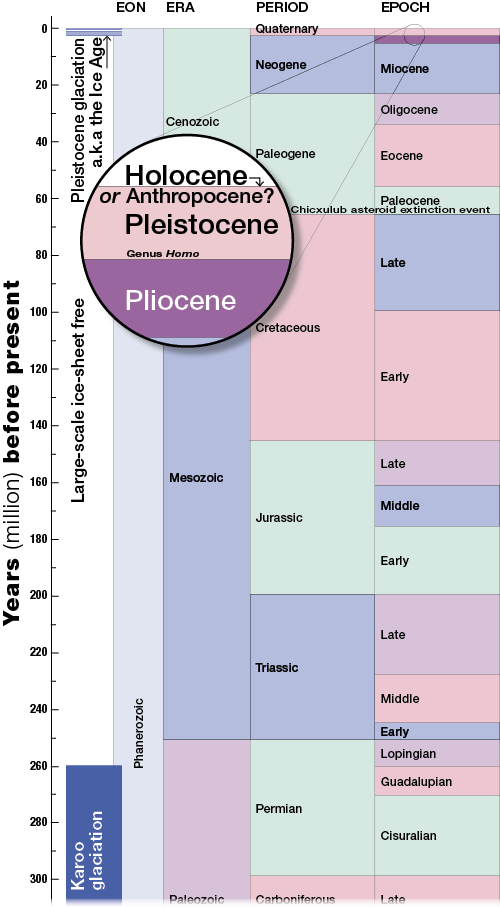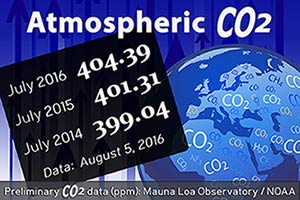Anthropocene ensures Holocene has had its day


Epochly Short-Lived: The 11 400-year Holocene makes a barely-discernable scratch across the end of the preceeding two epochs. The Anthropocene coined by Paul Crutzen would shave more off it. While some argue that the Holocene is merely part of the Pleistocene, that epoch—the Ice Age—may have already ended. infographic Mahurangi Magazine
Geology was one of Ronald Locker’s abiding passions. In his chapter Laying the Foundations, Jade River : A History of the Mahurangi’s author succinctly explains the processes that gave rise to the Mahurangi—how this landscape of outstanding natural beauty came to be.
Locker would have loved that in the few decades since he wrote his potted account of it, the geology of Aotearoa got curiouser and curiouser. The revelation that it was the short-lived continent of Zealandia that separated from Australia and the rest of Gondwanaland, rather than Aotearoa. And that Aotearoa was later formed from that drowned continent, by a complex collision of the mighty Indo-Australian and Pacific plates.
He would have relished the remaining mystery as to whether any tiny remnants of continent remained above water to provide stepping stones for the dwindling portion of Aotearoa’s flora and fauna that could have conceivably come on the original ride—the vast bulk having arrived since there was a substantial Tasman Sea. And worshipped the uniqueness of the Land of Birds even more devoutly.
In its less fantastic, but never-the-less entirely fascinating form, Locker tried out his presentation of Mahurangi geology on an elderly relative, hoping to excite him with new insights into his surroundings. The response:
A load of bullshit!—how can they know!
In an effort to keep his geology accessible, Dr Locker avoided referring to a litany of eons, eras, periods and epochs. His characteristic grasp of the big picture is evident when he describes the modern era of geology as the Ice Age. Locker was well to avoid the term Holocene, as it may go down in stratigraphic history as the shortest-lived epoch ever.
The immediate threat dates from 2000 when the atmospheric chemist Paul Crutzen advocated for the establishment of the Anthropocene—the term and concept coined by Dr Eugene Stoermer, in the early 1980s. If anyone deserves the honour of establishing an epoch for human impact it is Crutzen, for his work on the hole in the ozone layer, for which he won a Nobel Prize in 1995. Stratigraphers have formally begun the prolonged and esoteric process of deciding whether to make the Anthropocene official, and if so from when.
As appropriate as it might seem—to date an epoch from when the ice cores show a marked increase in greenhouse gases marking the beginning of the Industrial Age—the concept raises cascading difficulties.
The first is that it would terminate the Holocene in its tracks at mere 11 000 and a bit years of age. Eleven thousand years is a blink of an eye compared to the other epochs, which generally span 5–50 million years. Brief as it was at 2.6 million years, the last ‘respectable’ epoch (the Pleistocene) was more than 200 times longer than the Holocene.
The second difficulty is that an emerging body of science is showing that humans have had a significant impact on the geological record for the greater part of the Holocene. The domestication of animal and plant species, the extinctions of others, sedimentation from deforestation all changed the landscape and the weather. It is arguably arbitrary to start an epoch when only the rate of change changed, with the advent of the steam engine. Fossil fuel burning was already well underway, thanks to the diminishing availability of firewood.
The third difficulty relates back to Ronald Locker’s, and others, preference for ignoring the Holocene, and regarding the latest warming period as simply part of the Ice Age—that preference neatly makes the entire, ‘ongoing’ ice age the Pleistocene. The problem with that is that James Hansen and others have drawn attention to strong probability the Ice Age has ended, thanks to anthropogenic greenhouse gases.
If that proves to be the case, and Hansen has been substantially and scarily accurate to date, it can be argued that the Ice Age ended about 10 000 years ago, leaving the Holocene a mere husk—two millennia.

Prolonged Understatement: Writing in the early 1990s, Dr Ronald Locker would have been with the majority of scientists in regarding greenhouse gases as merely prolonging an interglacial. infographic CO2Now
The Holocene was named by the 1885 International Geological Congress, which was shortly after the science supporting ice ages began to be widely accepted. Given that there was no reason then to suppose that the Ice Age had ended, the congress appears to have had no business announcing a new epoch. But it now appears that the geologists got it nearly right, albeit for the wrong reason. However the name itself, meaning entirely recent, was never going to stand the test of time.
As recently as the mid-1990s, Dr Locker probably represented the majority of scientists with his view:
We still live in the Ice Age, but are enjoying a relatively mild interglacial, which we are doing our best to prolong by the ‘greenhouse effect.’
The section titled Glaciation and the Thaw refers to the last glacial period, and its thaw. If he were writing his history today, it would warrant a chapter: Last Glaciation, Last Thaw. Hansen would have it stronger: Final Glaciation, Final Thaw.
And Holocene might rate a mere footnote, audaciously but appropriately replaced by Anthropocene—recent, man.
The first man-made epoch.
